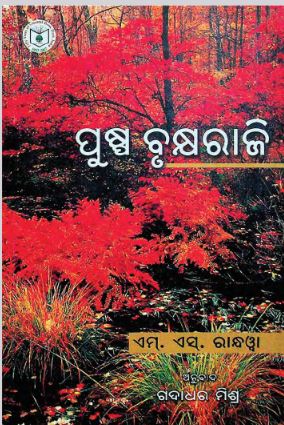Published in 2007, “Puspa Bruksharaji” by M.S. Randhawa, translated into Odia by Gadadhar Misra, is a remarkable work that blends science, environmental awareness, and the beauty of nature through the lens of Odia literature. The book stands out not just as an informative piece but as a profound exploration of the ecological significance of plants and trees, particularly focusing on the essence of flowering trees and their roles in our ecosystem.
At the heart of “Puspa Bruksharaji” lies a rich tapestry of scientific knowledge woven into the narrative of ordinary life. Randhawa’s mastery in botany shines through as he delves into the anatomy of trees, their physiological processes, and the critical roles they play in sustaining life on Earth. The author emphasizes the importance of biodiversity, illustrating how various species contribute to ecological balance. The book goes beyond mere descriptions, offering readers a deep understanding of photosynthesis, seed dispersal, and the intricate relationships plants share with their environment.
One of the most compelling aspects of the book is its call to action regarding plantation and conservation. With increasing urbanization and deforestation threats, “Puspa Bruksharaji” serves as a timely reminder of the need to appreciate and protect our natural resources. Randhawa presents plantation not just as an environmental necessity but as a moral responsibility that rests on the shoulders of every individual. The transformative power of planting trees is eloquently portrayed, highlighting the various economic, social, and environmental benefits that arise from greening our surroundings.
The narrative encourages readers to engage in plantation drives, appreciating the aesthetic value of trees as well as their functional benefits such as providing oxygen, improving air quality, and supporting wildlife. The scientific insights blended with practical advice make the book a crucial resource for educators, students, and environmental enthusiasts aiming to promote green initiatives.
Beyond its scientific narrative, “Puspa Bruksharaji” is a literary masterpiece. Randhawa’s poetic expression brings the flora to life. The vibrant imagery he uses to describe flowering trees evokes a sense of wonder and appreciation for nature. Gadadhar Misra’s translation into Odia retains this lyrical quality, making it accessible to a broader audience. The Odia language intricately captures the essence of nature, allowing readers to feel connected to their environment in a culturally resonant way.
The book also reflects on the traditional knowledge and practices of Odisha, merging them with modern scientific understanding. This cultural richness adds another dimension to the work, asserting the significance of indigenous knowledge in contemporary discussions on sustainability and conservation.
“Puspa Bruksharaji” serves as more than just an essay book; it is a critical commentary on the pressing environmental issues faced by our world today. It inspires individuals to cultivate a deeper connection with nature and become active participants in the movement for conservation and sustainability. As we confront challenges such as climate change and diminishing green spaces, Randhawa’s work stands as a beacon of hope, urging us to plant the seeds of change—both literally and figuratively. This book is essential reading for anyone looking to understand the interplay between science, nature, and humanity
Books Info
| Books name | Puspa Bruksharaji/ପୁଷ୍ପ ବୃକ୍ଷରାଜି |
| Author | MS Randhawa; Gadadhar Misra, Tr. |
| No Of pages | 238 |
| Publisher | National Book Trust India |
| Publication | 2007 |
| Printed At | National Book Trust India |
| Distributor | NA |

